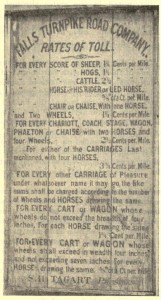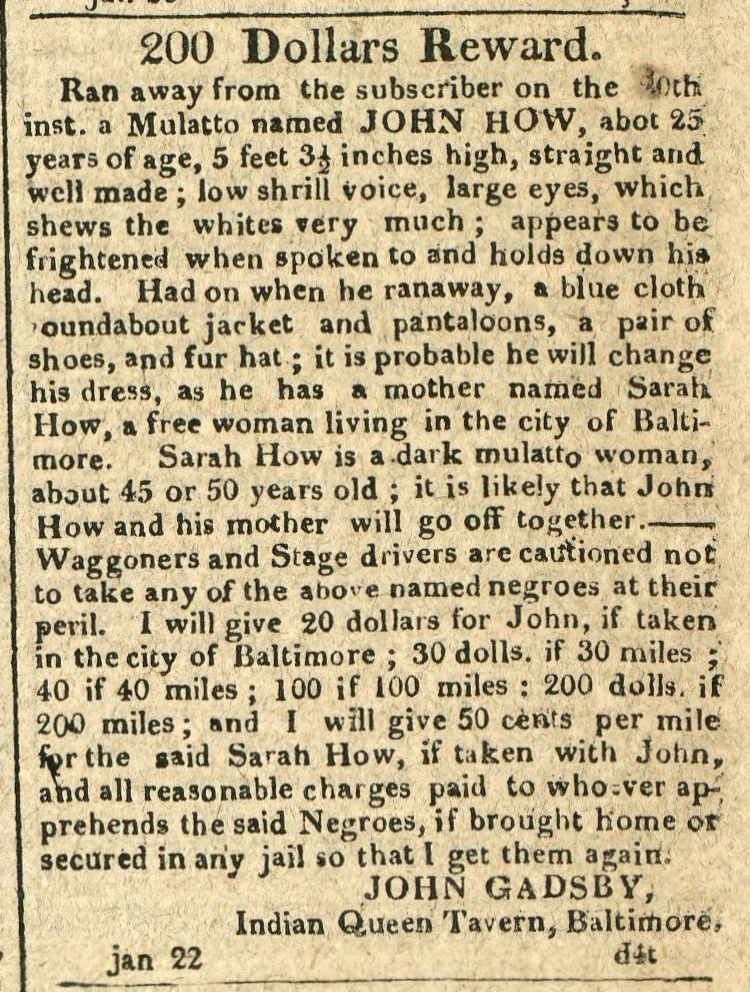“25 – Very fine day & mild, Wind NW – Went to Town return’d to Dinner
From the journal of Captain Henry Thompson, January 25, 1814. Courtesy the Friends of Clifton.
“25 – Very fine day & mild, Wind NW – Went to Town return’d to Dinner
From the journal of Captain Henry Thompson, January 25, 1814. Courtesy the Friends of Clifton.
On January 25, 1814, mechanic John Owings received two patents for the design of a new water mill and an impressed roller for the production of “knives, spoons, etc.” Born in Baltimore around 1780, Owings lived in the city’s Western Precincts at Paca and Franklin Streets. He later served as a Captain under Colonel Jessop in the 36th Regiment of the Maryland Militia.
“24 – Commenc’d raining before day & continued until 2 PM Wind South Went to Town in my Gig, drove Jack the Mule, return’d to Dinner Hung up remainder of my Bacon
From the journal of Captain Henry Thompson, January 24, 1814. Courtesy the Friends of Clifton.

On January 24, 1814, the Maryland legislature joined Pennsylvania in chartering a new turnpike company to connect Lancaster County to Baltimore. The state offered a detailed and descriptive title: “An act to enable the governor of this commonwealth to incorporate a company for making an artificial road by the best and nearest route from the Philadelphia and Lancaster turnpike road through the village of Strasburg in Lancaster county to the Susquehanna bridge at McCall’s ferry and from thence to Baltimore.”
In the 1810s, states established countless turnpike companies but road-building remained a potentially challenging and speculative venture. Some projects like the Baltimore and Havre-de-Grace Turnpike (chartered in 1813 but unfinished until 1825) took years to complete. Others, including this road from Baltimore to Strasburg, were never built at all.

On January 6, Commodore Oliver Hazard Perry received a Congressional Gold Medal for his service at the Battle of Lake Erie. Make sure to sign up for our email newsletter to get more updates on Perry’s celebratory visit to Baltimore at the end of the January 1814.
“23rd Sunday – Cloud day and mild, Wind S – Rode to Town & went to Church, afterward accompanied Gen. Ridgely & R. Patterson to D.A. Smiths to Dinner, came home early, having an appearance of Rain ~
From the journal of Captain Henry Thompson, January 23, 1814. Courtesy the Friends of Clifton.“
“22 – Fine day but very cold, went to Town & din’d at Gadsbys with Mr. Jas. Sanderson – A Lamb last Night
From the journal of Captain Henry Thompson, January 22, 1814. Courtesy the Friends of Clifton.
Jan. 22nd
At half past 11 A.M. lat. 31, 48, long. 70, 20, discovered a sail from mast head, distant about 15 miles; made all sail in chase, it blowing fresh and squally. – At 5 P.M. the chase hoisted the American ensign at the main peak; at the same time made her out to be a foretopsail schooner – shewed our American ensign and continued under a press of sail to chase, coming up very fast, the chase at this time being distant about two and a half miles. At half past 9, lost sight of her in a squall, when about to fire a chase gun.
From the journal of the Chasseur, excerpted in Baltimore American, June 2, 1814. Maryland Historical Society.
Subscribe to receive our weekly updates by email or check out our review of stories from January 16-22, 1814 on the Baltimore Heritage blog.

John Gadsby, the English-born proprietor of the Indian Queen Tavern, had arrived in Baltimore from Alexandria, Virginia in 1808. On September 29, 1809, traveler Samuel Breck stopped in Baltimore and stayed at the Indian Queen, observing:
“We alighted at the Indian Queen in Market street, kept by John Gadsby in a style exceeding anything that I recollect to have seen in Europe or America. This inn is so capacious that it accommodates two hundred lodgers, and has two splendid billiard-rooms, large stables and many other appendages. The numerous bed-chambers have all bells, and the servants are more attentive than in any public or private house I ever knew.”
In 1813, John Gadsby held thirty-six enslaved people at the Indian Queen to support the “attentive” service of his establishment. According to the 1813 Baltimore tax records, the value of the enslaved people held by just twelve tavern or innkeepers exceeded the total value of their real estate.
Sources: Breck, Samuel, and Horace Scudder. 2007. Recollections of Samuel Breck. Applewood Books. p. 266; Rockman, Seth. 2010. Scraping By: Wage Labor, Slavery, and Survival in Early Baltimore. JHU Press. p. 112.